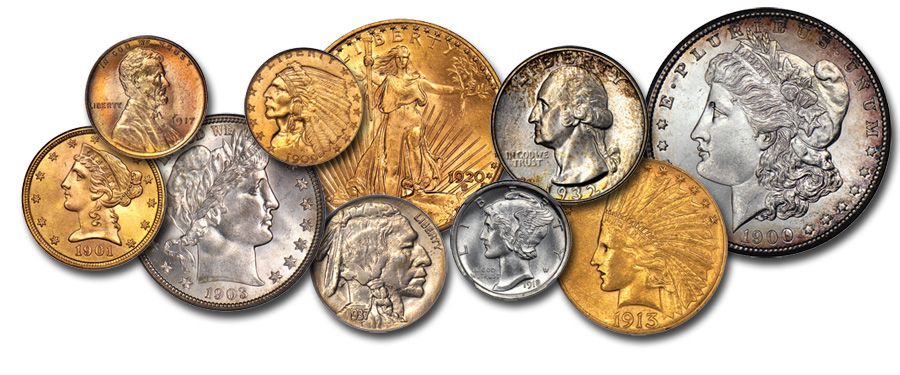
In this final part, I conclude my discussion of building a type set of 20th-century coins (1900 to 1999) by describing the gold coins of that era.
The quarter eagle was the smallest regular-issue gold coin minted in the 20th century. The first design is the Liberty Head type by Christian Gobrecht, essentially unchanged since its introduction in 1840. During the 20th century Liberty Head quarter eagles were struck at the Philadelphia Mint from 1900 through 1907 inclusive.
Then followed the Indian Head type by Bela Lyon Pratt, introduced in 1908 and made intermittently through 1929. This motif and the related $5 design had their features recessed in the field and were widely criticized by numismatists at the time, with the result that not many were saved. Today the attitude is different and examples are in strong demand.
The Liberty Head half eagle with the obverse by Christian Gobrecht launched in 1839 and with the motto IN GOD WE TRUST added in 1866 was continued into the early 20th century, struck from 1900 through 1908. Take your pick of your favorite date and mint.
In 1908 the Indian Head design by Bela Lyon Pratt was introduced. The motifs are recessed in this coin, as well as the quarter eagle, an interesting departure from former styles. These coins were struck intermittently through 1929.
$10 gold eagles of the Liberty Head type by Christian Gobrecht and first made in 1838, were continued into the 20th century. The motto IN GOD WE TRUST had been added to the reverse in 1866. 20th-century varieties were made from 1900 through 1907 inclusive. Examples are plentiful.
The Indian Head design by Augustus Saint-Gaudens made its debut in 1907. The motto IN GOD WE TRUST was not present, due to the preference of President Theodore Roosevelt. The motif was produced from autumn 1907 through the first part of 1908.
In 1908 Congress added the previously absent motto on the reverse, creating the second type, struck intermittently from 1908 through 1933.
Double eagles are the next denomination under consideration. Examples of the Liberty Head type, designed by James B. Longacre in 1849, were produced through the early 20th century. The reverse with the denomination spelled out as TWENTY DOLLARS, introduced in 1877, was in use during that later time. Take your pick of any number of date and mintmark varieties from 1900 through 1907.
In 1907 the beautiful MCMVII High Relief double eagle by Augustus Saint-Gaudens made its debut and created a sensation. Slightly over 12,000 were minted totally. Today this remains a numismatic favorite. Examples are expensive due to the demand for them, making this the most costly addition to your 20th-century type set.
In December 1907 the design was modified to low relief and regular 1907 numerals. There was no motto, the result of President Theodore Roosevelt objecting to its use. Coins of this type were made in 1907 through early 1908.
In 1908 Congress added the motto IN GOD WE TRUST to the reverse, creating the last double eagle type, produced intermittently from 1908 through 1933.
This concludes the coins needed for a basic type set of 20th-century United States coins. If you want to go further, there are other avenues to explore — such as many different commemorative coin designs in the 20th century and, beginning in 1986, American silver and gold Eagles. However, these are different specialties.





